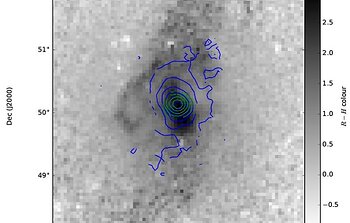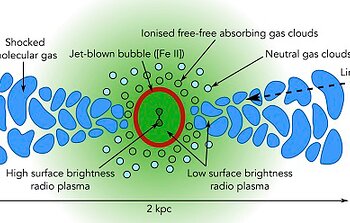Bubble Blowing Black Hole Jet’s Impact on Galactic Evolution
February 6, 2019

Astronomers using adaptive optics on the 8-meter Gemini North telescope have resolved, for the first time in near-infrared light, a giant elliptical galaxy with a young radio jet down to unprecedented scales. The observations also show how the jets, emanating from a black hole at the center of this galaxy, are heating the interstellar medium, which may have a significant impact on the evolution of the host galaxy.
Using adaptive optics (AO) and near-infrared imaging on the 8-meter Gemini North telescope in Hawai‘i, a team of astronomers lead by PhD student Henry Zovaro (The Australian National University) report the discovery of shocked molecular and ionized gas resulting from a jet-driven feedback coming from the center of a compact radio galaxy. The discovery offers important information on how such activity can influence the evolution of its host galaxy.
The galaxy, which goes by the name MCG 5-4-18, is a nearby giant elliptical galaxy harboring a young compact radio source, known as 4C 31.04, powered by a supermassive black hole with powerful jets. The radio source has two edge-brightened lobes (separated by about 320 thousand light years) that may only be a few thousand years old. The researchers demonstrate that 4C 31.04 is currently in a early phase of jet evolution, called the “energy-driven bubble” stage, where the jets inflate a bubble that expands out of the plane of the disk and interacts strongly with the galaxy’s interstellar medium.
The relative closeness of 4C 31.04 (about 270 megaparsecs, or 900 million light years) enabled the team to probe the interactions between the radio jet and the surrounding interstellar medium using H- and K-band infrared observations obtained with Gemini’s Near-infrared Integral Field Spectrometer (NIFS). “This is the first time that observations in optical or near-infrared have resolved the host galaxy down to scales comparable to the size of the radio lobes,” Zovaro says.
The shocked gases discovered by the team are important because they serve as tracers of the energetic interactions between the jet and the surrounding material. The study uncovered two different phases of heated gas in the circumnuclear disk: 1) the innermost parts of the disk form a jet-blown bubble of ionized gas 1,300 light years in diameter; and 2) the outer region is comprised of very warm molecular gas, around 1,000 Kelvin, reaching distances greater than 3,000 light years (Figure 1).
Zovaro explains how the two phases are related (Figure 2): “The bubble pushes a forward shock into the interstellar medium, giving rise to the ionized gas. Jet plasma also percolates into the circumnuclear disk, shocking and radially accelerating gas clouds, warming the interstellar medium and giving rise to the molecular emission.” Zovaro suggests that the warm molecular gas is part of the extended structure of the massive circumnuclear disk. Because the molecular gas cools rapidly, he says, this phase is very short-lived, and only represents a very small fraction of the total warm mass.
“All of the images of the radio emission that are currently available only show the jets reaching distances of about 100 parsec from the nucleus, whereas our NIFS data show that, in fact, the jet’s plasma reaches all the way out to approximately one kiloparsec in the disk,” Zovaro says, noting that deeper radio observations would be required to detect the jets at such radii. “This is an important finding,” he adds, “because it shows that we can’t simply ignore the effects of radio jets upon the evolution of their host galaxy, even if the radio source appears to be very small.”
The Gemini observations are featured in the accepted paper in the Monthly Notices of the Royal Astronomical Society.

